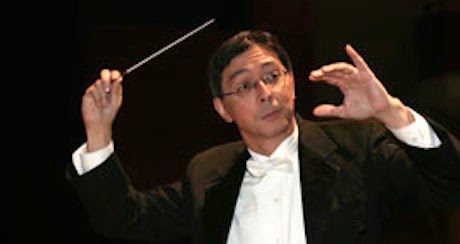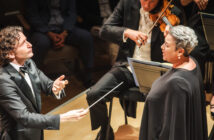 |
Liszt: Les Préludes
Korngold: Violin Concerto
Dvořák: Symphony No. 7 in d Minor Op. 70
Gil Shaham, violin
Austin Symphony/Peter Bay
Austin, Texas
When the still boyish Gil Shaham comes bounding on stage, violin in hand, with a huge smile on his face, you know you are in for a special kind of music-making. Shaham, now 43, still seems the charming prodigy he was when he first came to international attention. Before playing so much as a note, he has the audience in the palm of his hand. This is clearly a young man who loves music and can’t wait to share it with everyone he meets. He shook concertmaster Jessica Mathaes’ hand so long and so hard I was afraid she might have to claim disability. Maestro Peter Bay also got the full Shaham treatment – before, during and after the performance. At one point during the performance, Shaham got so close to the podium, I thought a referee might have to be summoned to call a penalty for soloist interference.
There are soloists who take the stage with the measured pace we associate with royalty, and give the audience the merest nod of the head to acknowledge their applause. Such self-important folks are seldom seen to crack a smile; for example, Jascha Heifetz, one of the greatest violinists of his era, totally deserved his nickname, “The Great Stone Face”.
 |
| Soloist Gil Shaham |
Shaham will have none of that. He knows as well as anyone that “serious music” is a serious business, and doing justice to Bach, Brahms and Beethoven and all the rest requires blood, sweat and tears; that said, he clearly subscribes to the notion that even “serious music” performers, are entertainers. Some – and he appears to fall into this category – even want to gift the audience with more than superb musicianship!
Standing Ovation/ Exquisite Bach
On this occasion, Gil Shaham played the Violin Concerto by Erich Korngold. The piece was written in 1945 for the afore-mentioned Heifetz but it is only in the last ten years or so that it has become truly popular; today, virtually all the leading soloists play the piece, with good reason. In addition to good tunes, many of them recalling scores that Korngold wrote for Hollywood films such as The Adventures of Robin Hood, The Sea Hawk and Deception, this concerto also has moments so funny that one could be forgiven for laughing out loud. It also supplies a virtuoso violinist with many opportunities to “strut” his stuff.
A recording of the Korngold Concerto 20 years ago featuring Shaham, Andre Previn and the London Symphony, remains one of the best readings on record of the piece. Shaham obviously still loves to play it – only last month he performed it in New York with Mehta and the Vienna Philharmonic.
On this occasion, Shaham and his “Countess Polignac” Stradivarius (c.1699) gave us a passionate and authoritative Korngold Concerto with Peter Bay and the Austin Symphony supplying fastidious support. Balances were, for the most part, ideal and ensemble precision was excellent. Three “in-and-out” standing ovations brought Shaham back for an encore: unaccompanied Bach with beauty of tone, joyous rhythms and vivid ornamentation.
 |
| Antonín Leopold Dvořák |
Melodies from Singing Winds
Dvořák’s Symphony No. 7 also got careful treatment from Maestro Bay. This approach paid dividends in the many pages of touching lyricism in the symphony. The Austin Symphony winds took turns making the most of their many opportunities to “sing” Dvořák’s inspired melodies. The symphony, however, also has moments of raw power and intensity, and these passages were often underplayed in this performance. A case in point is the great climax toward the end of the first movement, in which Dvořák builds the excitement bar by bar into a ferocious fortissimo for the full orchestra. The key to building the climax here is increasing the tempo at exactly the right moments. For whatever reason, Maestro Bay appeared to totally ignore Dvořák’s marking “poco a poco accelerando,” and failed to summon anything close to the volume that building the climax bar by bar to its shattering conclusion requires.
The same could be said of the closing bars of the last movement, except that here the conductor needs to hold back the tempo to fully realize the spirit of Dvořák’s “Molto maestoso” marking.
The last ten bars of the symphony have another problem that each conductor must solve for him/herself. As written, the melody is given to the second violins and doubled by oboes, clarinets and bassoons. With the rest of the orchestra playing mostly fortissimo long notes, the melody can scarcely be heard. One solution is to have the louder instruments – trumpets, trombones and timpani – back off in volume to let the melody come through; this solution, however, drains most of the excitement out of these closing bars. Maestro George Szell, an authoritative interpreter of the music of Dvořák, solved the problem by having the trumpets play the melody along with second violins, etc. – a very effective solution, which many conductors have adopted. Maestro Bay chose a middle course – horns doubling the melody – which worked rather well.
On this occasion, Peter Bay and the Austin Symphony gave us a Dvořák Seventh that was carefully prepared, but to my taste, much too polite for the essence of the piece.
For something more…
While on exclusive contract with Deutsche Grammophon, Gil Shaham recorded most of the major violin concertos in the repertoire. Today, nearly everything has changed in the record business and few artists are under either exclusive or long-term contracts.
Shaham now records mostly for Canary Classics. His latest release has the unusual title “Music to Drive Away Loiterers,” a title which refers to the recent discovery that if classical music is played in subway stations or shopping malls, people don’t hang around (i.e. “loiter”) and so there is less crime in such places. The CD includes some of the most beautiful music ever written.
For more about Erich Korngold visit www.korngold-society.org; this website keeps close track of performances and recordings of Korngold’s music.
Paul Robinson is the author of Herbert von Karajan: the Maestro as Superstar, and Sir Georg Solti: His Life and Music. For friends: The Art of the Conductor podcast, “Classical Airs.”














